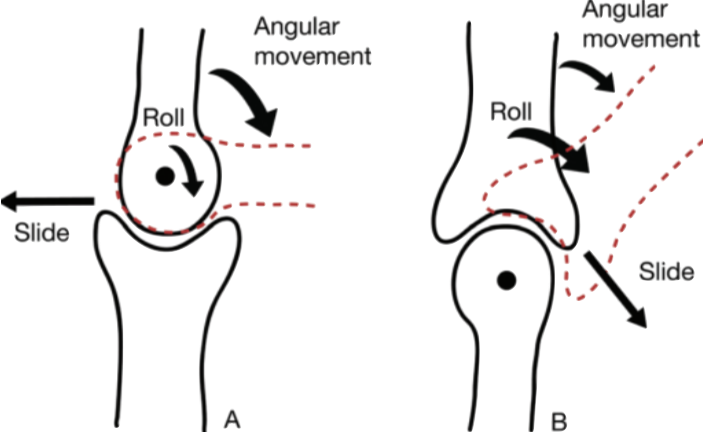Mobilization/Convex-Concave Rule. NPTE Study Guide: Master the NPTE
Osteokinematics: Movement between bones. Osteo=bones. Kinematics=study of motion
Arthrokinematics: Movement between joint surfaces. Artho = joint.
 Joint Arthrokinematics:
Joint Arthrokinematics:
Roll: One joint surface rolling on another in a certain direction (tire rolling on road)
Glide/slide: Pure translatory motion of one surface gliding on another. Takes place within the joint (braked wheels skidding)
Spin: Rotation of a movable component of a joint (Note: Not commonly on the NPTE)
Concave–Convex Rule: Describes the relationship between osteokinematics and arthrokinematics
Concave: Hollowed or rounded inward. Concave on convex: glide occurs in the same direction. If a moving surface is concave, the slide occurs in the same direction as the roll. Mnemonic—concAve=sAme. Example: elbow flexion—Roll & slide are both occurring anteriorly; Ulna (concave) is moving on the humerus (convex).
Convex: Curved or rounded outward. Convex on concave: glide occurs in the opp direction. If a moving surface is convex, the slide occurs in the opp direction of the roll. Mnemonic: cOnvex = Opposite. Example: shoulder abduction—Roll is occurring superiorly, whereas slide is occurring inferiorly; Humerus (convex) is moving on the glenoid fossa (concave).
Thumb Mechanics: The thumb is a saddle joint, so it has two different planes.
1. Radial adduction (flexion) and radial abduction (extension). Concave on convex: distal concave moves on proximal convex (same direction). Radial adduction (flexion) = ulnar glide. Radial abduction (extension) = radial glide
2. Palmar adduction and palmar abduction. Convex on concave: distal convex moves on proximal concave (opposite direction). palmar adduction = volar (anterior) glide. palmar abduction = dorsal (posterior) glide
3. Examples: When we think of the rolling of the 1st digit, your first digit is giving you the answers. As we go into first-digit flexion (FLX), the first digit is pointing to the ulnar side of
your arm, telling you that it’s an ulnar roll. As we go into first-digit extension (EXT), the first digit is pointing to the radial side
of your arm, telling you that it’s a radial roll. If you have trouble remembering which is first-digit EXT, think back to that
anatomical snuff box. One must do first-digit EXT to get it to be prominent. As we go into first-digit abduction (ABD), the first digit is creating a “V” (first and second digits), telling you that it’s rolling volar. As we go into first-digit adduction (ADD), the first digit is coming into your hanD (so you can slap this upcoming NPTE exam), telling you that it’s rolling dorsal. First-digit FLX and EXT are both concave on convex, so roll and slide (glide) are
in the same direction. First-digit ABD and ADD are both convex on concave, so roll and slide (glide) are in opposite directions.